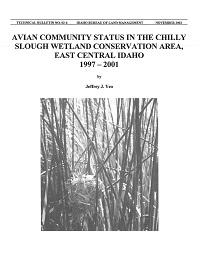Avian Community Status in the Chilly Slough Wetland Conservation Area, East Central Idaho 1997-2001

The Chilly Slough Wetland Conservation Area (CSWCA) protects almost 2,000 acres of a 5,000-acre high-desert wetland in the Thousand Springs Valley, the largest wetland in east central Idaho. Managed jointly by the Challis Field Office of the Bureau of Land Management (BLM) and the Upper Snake River Regional Office of the Idaho Department of Fish and Game, primary management concerns are protecting the wetland for waterfowl and neotropical migratory birds. From 1997 through 2001, systematic surveys of birds in the CSWCA assessed bird species composition, bird habitat affiliations, breeding bird abundance, and waterfowl brood production. Seventy-two bird species in 21 families were observed using the CSWCA from 1997 to 2001 during the spring-fall period. Peregrine falcon, formerly an endangered species, was observed using the wetland in summer 1999 and 2001. Trumpeter swan, a species considered critically imperiled in Idaho, used the CSWCA during spring migrations. Forty-one species of birds were observed during breeding bird surveys counted from points along transects. Annual water levels in Thousand Springs Creek fluctuated in concert with annual March - July precipitation. Breeding bird densities were correlated with March - July precipitation (r = 0.97). About 40 species nest in the CSWCA in most years including at least 13 species of waterfowl. The ratio of waterfowl young to adults also was correlated with March - July precipitation ( r = 0.95). The baseline data obtained in this 5-year monitoring effort exemplifies the value of the protection of large portions of the Chilly Slough wetland. Management of the CSWCA should focus on maintenance of existing protection ( e.g., livestock exclusion, ACEC and RNA designations), acquisition of additional wetland with the view of maintaining water level dynamics (i.e., protection of the source springs in the North Unit), and continued monitoring of biodiversity. A potential major threat to the CSWCA is the invasion and dominance of exotic plants. Continued, less rigorous avian monitoring of the CSWCA is recommended.
